Boletus L.
Recent molecular studies have shown that Boletus in its current circumscription is likely an artificial grouping and it is possible that it will be split at some point into smaller genera. Note that Boletus impolitus and Boletus depilatus for practical reasons are retained here, although there is strong evidence that they are closely related to Xerocomus subtomentosus and its allies.
Fruitbody large to medium sized, boletoid, without veil and ring. Stipe solid, with surface usually covered with granules or network. Flesh variously coloured, changing or not when exposed to air. Tubes easily separable from each other, not tearing apart. Pores usually small and rounded.
Boletus edulis Bull. : Fr.
Description
Cap up to 20cm, hemispherical, then convex, flat convex or flat, more or less viscid, darker in the center, paler towards the margin, beige, pale brown, brown to dark brown, sometimes greyish, not blueing when bruised. Stipe club-shaped, cylindrical or sometimes tapering towards the base, bulbously swollen or rooting, white or whitish to pale brownish, with well defined network, not blueing when bruised. Flesh white, sometimes spotted brownish at the stipe base, rarely somewhat pinkish below the cap cuticle, unchanging when exposed to air. Tubes initially white, then cream, pale yellow to yellow with olivaceous tint, unchanging when exposed to air. Pores concolorous with the tubes, unchanging when bruised. Smell not distinctive. Taste not distinctive. Spores 12.0–19.5 × 4–7 μm, ratio 2.5–3.9. Pileipellis (the cap cuticle) trichodermium of interwoven septate, slightly gelatinized hyphae. Cells of the hyphae long cylindrical, not incrusted. Chemical reactions: hyphae of flesh in the stipe base inamyloid with Melzer’s solution.
Habitat. Coniferous, mixed and broadleaf forests, mycorrhizal with conifers – spruce (Picea), fir (Abies), pines (Pinus), or with deciduous trees – beech (Fagus) and birch (Betula).
Distribution. In Europe widespread, mostly mountain species in south.
Note. In the past there was a number of similar species recognized. Boletus betulicola (Vassilkov) Pilát & Dermek, growing with birch and having grayish cap, B. persoonii Bon with entirely white fruitbodies, and B. venturii Bon having yellow cap. Recent molecular research have proven that all three of them are very closely related with B. edulis, and that is why some authorities reduce all three taxa to mere forms of B. edulis. However, there is no consesus among the boletologists and some other authors still treat B. betulicola as a separate species (see Korhonen & al. 2009).
Photographs

Young and mature fruitbodies of Boletus edulis. (photo B. Assyov)
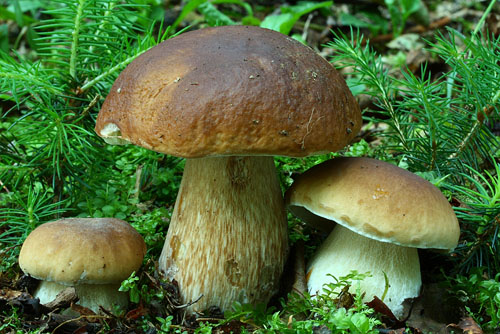
Fruitbodies of Boletus edulis of different ages. (photo M. Mikšík)
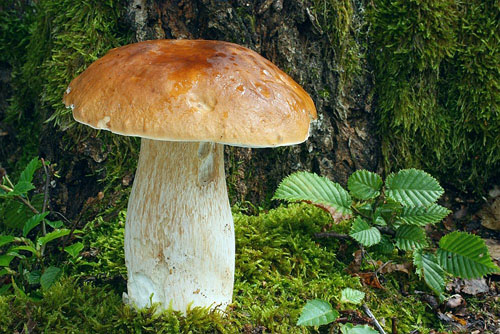
Fruitbody of Boletus edulis. Note the pale stipe. (photo M. Mikšík)
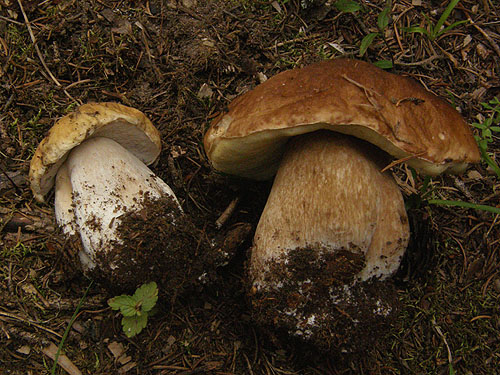
Fruitbodies of Boletus edulis. Note the colour of the pores. (photo B. Assyov)

Mature fruitbody of Boletus edulis. (photo I. Assyova)
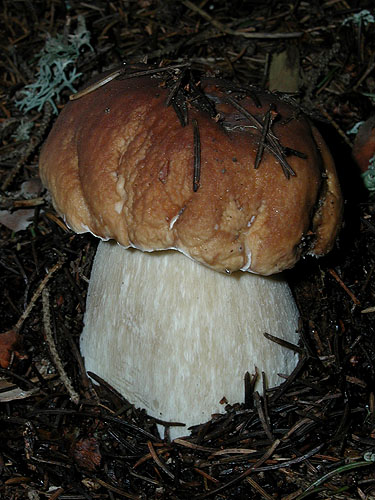
Young fruitbody of Boletus edulis. (photo B. Assyov)

Fruitbodies of Boletus edulis with yellowish caps. These were formerly known as Boletus venturii and are now commonly referred as B. edulis f. citrinus. (photo M. Mikšík)
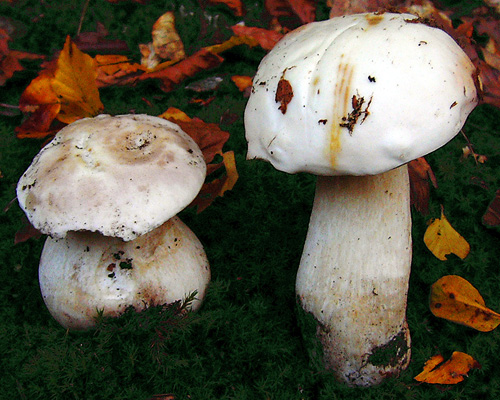
White fruitbodies of Boletus edulis. In the past such collections were called Boletus persoonii. Now they are known as B. edulis f. albus. (photo G. Konstantinidis)
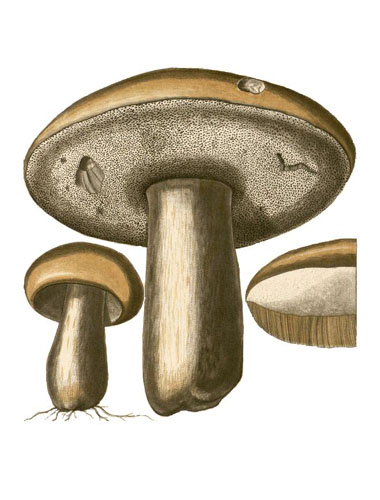
Bulliard's illustration accompanying the original description of Boletus edulis.
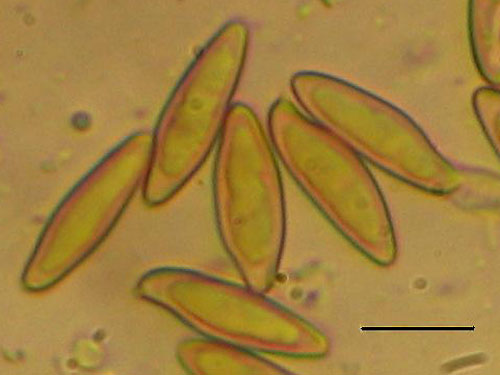
Spores of Boletus edulis. Scale bar = 10 μm. (photo B. Assyov)
Important literature
Alessio, C.L. 1985. Boletus Dill. ex L. (sensu lato). – In: Fungi Europaei. Vol. 2. Pp. 1–705. Libreria editrice Biella Giovanna, Saronno.
Alessio, C.L. 1991. Supplemento a Boletus Dill. ex L. (sensu lato). – In: Fungi Europaei. Vol. 2A. Pp. 1–126. Libreria editrice Biella Giovanna, Saronno.
Breitenbach J. & Kränzlin F. 1991. Pilze der Schweiz. Bd. 3(1). Röhrlinge und Blätterpilze. Verlag Mykologia, Luzern.
Dentinger, B.T.M., Ammirati, J.F., Both, E.E, Desjardin, D.E., Halling, R.E., Henkel, T.W., Moreau, P.-A., Nagasawa, E., Soytong, K., Taylor, A.F., Watling, R., Moncalvo, J.M. & McLaughlin, D.J. 2010. Molecular phylogenetics of porcini mushrooms (Boletus section Boletus). – Molecular Phylogenetics and Evolution 57: 1276–1292. (available online)
Engel, H., Krieglsteiner, G., Dermek, A. & Watling, R. 1983. Dickröhrlinge. Die Gattung Boletus in Europa. Verlag Heinz Engel, Weidhausen b. Coburg.
Estadès, A. & Lannoy, G. 2004. Les bolets européens. – Bulletin Mycologique et Botanique Dauphiné-Savoie 44(3): 3–79.
Galli, R. 1998. I Boleti. Atlante pratico-monographico per la determinazione dei boleti. Edinatura, Milano.
Hansen, L. & Knudsen, H. 1992. Nordic Macromycetes. Vol. 2. Polyporales, Boletales, Agaricales, Russulales. Nordsvamp, Copenhagen.
Knudsen, H. & Vesterholt, J. [eds.]. 2008. Funga Nordica. Nordsvamp, Kopenhagen.
Lannoy, G. & Estadès, A. 2001. Les Bolets. Flore mycologique d’Europe. Documents Mycologiques Mémoire Hors série no. 6. Pp. 1–163. Association d’Écologie et de Mycologie, Lille.
Korhonen, M., Liimatainen, K. & Niskanen, T. 2009: A new boletoid fungus, Boletus pinetorum, in the Boletus section Boletus from Fennoscandia (Basidiomycota, Boletales). – Karstenia 49: 41–60.
Muñoz, J.A. 2005. Boletus s. l. – In: Fungi Europaei. Vol. 1. Pp. 1–951. Edizioni Candusso, Alassio.
Pilát, A. & Dermek, A. 1974. Hríbovité huby. Československé hríbovité a sliziakovité huby (Boletaceae – Gomphidiaceae). Veda, Bratislava.
Singer, R. 1967. Die Röhrlinge. II. Die Boletoideae und Strobilomycetaceae. – In: Die Pilze Mitteleuropas. Vol. 6. Pp. 1–151. Julius Klinkhardt Verlag, Bad Heilbrunn.
Šutara, J., Mikšík, M. & Janda, V. 2009. Hřibovité houby. Čeled’ Boletaceae a rody Gyrodon, Gyroporus, Boletinus a Suillus. Academia, Praha.
Watling, R. 1970. Boletaceae, Gomphidiaceae, Paxillaceae. – In: Henderson, D.M., Orton, P.D. & Watling, R. [eds]. British fungus flora. Agarics and Boleti. Vol. 1. Royal Botanic Garden, Edinburgh.
Watling, R. & Hills, A.E. 2005. Boletes and their allies (revised and enlarged edition). – In: Henderson, D.M., Orton, P.D. & Watling, R. [eds]. British Fungus Flora. Agarics and boleti. Vol. 1. Royal Botanic Garden, Edinburgh.